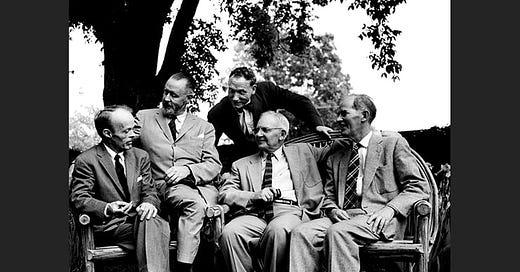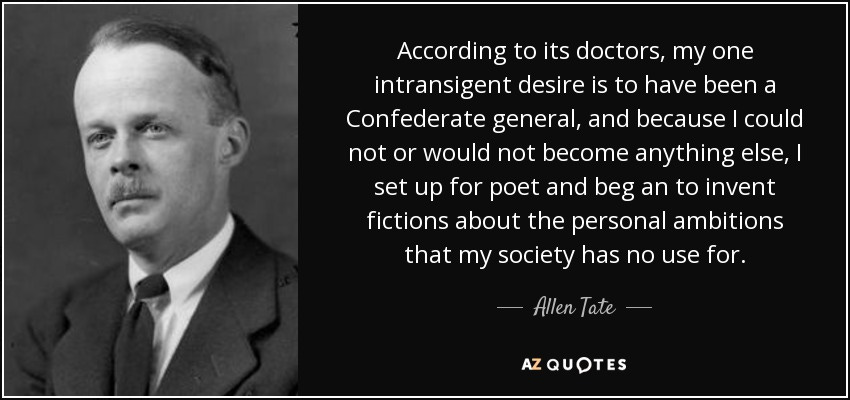The 20th Century Permanent Agriculture Revolution
That one time the United States almost accidentally stopped climate change and became a leading global force in defense of ecology. Part 2
To this point, we have focused on a particular aspect of the work to create a holistic agriculture that was based in permanent crops, predominantly native crops. However, there was also a reactionary, albeit smaller side to the agrarian movement that took hold as well, known as the Southern Agrarians. Unsurprisingly, the advocacy for this movement stemmed from southern culture and identity, downplaying the role of slavery in the civil war but instead focusing on the inalienable rights of rural southerners. While they didn’t gain any meaningful traction in the public eye, the reverberations of their work is still felt today and is worth studying.1
The Southern Agrarians, also known as the Nashville Agrarians, advocated for a number of progressive policies, including aggressive inheritance taxes on poor land stewards, bans on speculative land purchases, fines for poor land management, and an advocacy that land stewardship should be the primary vocation for a majority of the general population. They were vehemently anti-urban and had some, we’ll call them interesting, positions, including poems in defense of segregation and also in support of separate but equal, yet also sternly in support of urban black communities which they portrayed as being suckered by the shiny lights of industrialism. In their advocacy of a sense of place, that place is specific and static—to a time of colonialism.
Discussion of pre-colonized land management or acknowledgement of a prior land ethic is oddly missing. As a left-leaning, all-white group from the south, the conspicuous absence of meaningful discussion around race and its role in restoration of southern homestead culture leaves a lot to the imagination, and we can trace this thread the civil rights era and ultimately into Wendell Berry’s work, which attempts to integrate the threads of this ideological position with rural black southern voices like Jean Toomer. This subject is deserving of its own series, but the short of it is that the Southern Agrarians ultimately were unable to maintain their unique mixture of politics, unsurprisingly, and they eventually either advocated for fascism, on the side of white supremacy (and in Allen Tate’s case, still against fascism), or they became disillusioned with agrarianism as a whole. Frank Owlsley, one of the members of the Southern Agrarians, advocated for a return to a “modified form of feudal tenure, where, in theory, the King or state has a permanent interest in the land”. In short, the movement was well-aware of its inconsistencies, and those inconsistencies eventually forced the movement apart.
Allen Tate is a uniquely pernicious figure in this conversation; in his collection of essays, you can find him coming close to blaming black people for their enslavement. He infers that race— not racism— has allowed for the cancerous growth of capitalism, most often referring to industrialism.2 The dance between industrialism, capitalism and a yearning for days of the yeoman, which all were blamed upon the enslaved, speaks to the very specific performance and argument which inexorably ties race, identity, and anti-industrialism into one package, which deflects the failures of the system on the system itself, but rather specific occupants which perpetuate the system. We see this very specific strain of anti-race studies/anti-industrialism today in the homesteading community, and this thread that we should all be watching very seriously, given the ties between this movement 100 years ago and the current homesteading iteration today.
In his words, “The peasant is the soil. The Negro slave was a barrier between the ruling class and the soil”. This thread is imperative to understanding the seemingly juxtaposed homesteading community with white supremacy, anti-globalism, and its uneasy relationship with capitalism and nationalism (and its lack of understanding of what capitalism is, exactly).
Eric Earnhardt, in his Masters thesis “Toward an Equitable Agrarian Commonwealth”, addresses this dichotomy sternly, stating that “in this same essay, Tate links the distance between master and slave, and therefore between master and land, as the malady of Southern art: the estrangement from image. “The white man got nothing from the Negro, no profound image of himself in terms of the soil… But the Negro, who has long been described as a responsibility, got everything from the white man”. While many critics that were sympathetic to the antibellum south believed Southern art suffered because of the moral stain of slavery, Tate offers a counterweight that centers the problems of Southern Identity not on the crime of slavery but rather on the enslaved themselves. Tate writes that critics are fundamentally right in his claim, but for the wrong reason.
Tate argues that southern culture’s roots, while closer to the land “in spite of the Negro” than those of the industrial North, they were not deep enough in the soil to produce great literature.
However, Tate argues that “It was not that slavery was corrupt ‘morally.’ Societies can bear an amazing amount of corruption and still produce high cultures. Black slavery could not nurture the white man in his own image”.
I’m willing to bet that as you’re reading this, you’re wondering why I’m focusing so heavily on a fairly marginal group of people. There’s a lot to unpack about this, and my hope is that you let it simmer, and consider how it weighs into the modern discussions of how the erasure of blackness and other marginalized communities plays out in these spaces today, particularly in relation to theft of indigenous practices in order to restore the “authentic” domain of the land that the enslaved worked. It would be easy to dismiss this movement, but it was reborn in the 1980s focused chiefly on Southern Identity and agrarianism. Its anti-capitalist underpinnings were largely ignored in favor of a defense of the quasi-guilded age that the movement calls culture. While the movement has had little mainstream success, its ideological inconsistencies, racial ignorance, and fluidity are worth understanding in the agrarian space.
The Roosevelt Administration
If the early 1920s epitomized the careless draw to unfettered capitalism, the early 1930s represented the sobering need for regulation, and the idea of planned permanence– planned economies, seemed inevitable. Rexford Tugwell, having advocated for fundamental changes since the 20s, was the man with the power to turn responsibility into policy. In his view, monocrops had become modern serfdom, and called for the withdrawal of public lands being used for individual homesteads through the homestead acts and demanded an end to overgrazing on public lands, while also pushing for the restoration of marginally-productive lands.3 His vision was complex; smaller-scale manufacturing built within hubs of small villages interwoven with public transportation.4 Individuals would only work part-time while stewarding subsistence plots, and the government would provide cutting-edge research for these homesteads while also switching land use from regional monocultures to regionally designated tree, fruit, or grassland agriculture.5
Wildly optimistic, it painted a future in direct contrast to what progress looked like to much of mainstream culture, which had only been removed from traditional agriculture within the past generation or two. Ultimately, the goal was for a fundamental improvement in rural living standards while respecting the needs of the local ecological systems. Unfortunately, these visions were in direct competition to the immediate needs of farmers, whose staple crops were not enough to feed their own families and were subsidized by that same government Tugwell represented. He couldn’t stop the freight train of conventional agriculture and also replace that same train with a perennial system.
What was particularly important about his vision, however, was it explicitly centered ecology as a philosophy at the center of this movement. A nascent science at this time, the need to prove the framework for this movement became increasing important in the 1930s.6 This decentered humanity and human needs and also provided a framework for humanity to re-organize society and human relations; the question became, how can humanity exist in more harmonious ways?
To fully understand and appreciate what this means, we have to understand how scientists understood the field of ecology. If you recall in our first episode, we discussed the framework of complex systems science. The Macy Conference, the first interdisciplinary science conference that was foundational in developing a cohesive understanding of what was then called “chaos theory”, was in 1941. Of course, while this was a defining moment in the codification of complex systems science, the idea of complex systems had entered into the economic sphere; Ludwig von Mises had extrapolated the general idea that economic systems were simply too complicated for any centralized power to effectively measure and distribute it. While there’s plenty of places to disagree with von Mises’s conclusion, the most important point here is that the economists who were heavily vested in soil restoration were well-aware of these ideas of complex systems, even if the terminology had not been canonized at this point.
Prior to this period, ecology was a quasi-unscientific study of plants. Ecologists up to the 1920s had developed the linear concept of succession in terms of ecosystems, and even applied economic language to these processes; for example, what we might call an ecotone today would be described as a “superorganism”, a nod to the Marxist term “superstructure”. 7
Fundamentally, the science was still topical and linear. Through the 30s and into the 40s, this was fundamentally being challenged as researchers discovered that succession wasn’t necessarily a progression but rather changing conditions which were more or less ideal for specific species, and that species co-evolved for those same similar conditions. In fact, it wasn’t until 1939 that the discussion that animals had co-evolved for specific ecosystems and were also necessary for plant health was fully developed.
A.G. Tansley was a particularly vocal ecologist in advocating for change from our conventional, monocropping systems. He was also increasingly uncomfortable with an ecology which strictly placed old growth ecosystems as what human management should be measured against, since we were not particularly well-suited for those environments.
Tansley suggested that we consider something of an anthropogenic climax, a modern landscape shaped by humans– something similar to the landscapes which once existed prior to colonization here in the United States.
This wasn’t the only area where ecology was still growing and building its proverbial roots; until the 1930s, the limited scope of ecology was explicitly focused in the domain of the ‘wild’ while our agriculture continued to have a hard division from the natural world. These were considered different subjects entirely, and that the knowledge gleaned in one did not apply to the other. In December of 1938, the president of the Ecological Society of America Herbert Hanson advocated for a need for ecology to “invade” the realm of agriculture and conservation. It wasn’t until the 1940s where application of ecological principles and ecologists were first addressing issues in agriculture directly, starting with Edward H. Graham attempting to reform pest problems in orchards by ending the process of clearing litter from beneath fruit trees in orchards.
Ultimately, what came from this convergence of ecologists and economists was a fundamental philosophical way to engage with ecosystem understanding, what we might call today a Land Ethic, a term that was extrapolated a decade later in Aldo Leopold’s Sand County Almanac. And while Leopold’s work is the one which history remembers, he was one of a number of ecologists & conservationists like Paul B. Sears who advocated for the same thing. What was fundamental, from Leopold to Sears to their Russian contemporary Kropotkin, was a desire to find a way out of the seemingly endless ecological and economic collapse taking place, and ultimately looking to nature for an answer. What underscored their need for nature to provide an answer was really what had caused the current state— humanity’s hubris. Sears argued that ecologists were effectively there to pick up the pieces of our lost relationship with the natural world, and to offer “laws of community development and behavior in such a way that they may be applied not only within the human community but to the wider community of living things… whose control he has assumed.”
What we can discern in retrospect from this time is how ecology hadn’t quite fully formed its identity around ecosystem restoration, and we can see how ecological solutions were able to fall into different solutions, from the organic movement to permaculture to agroecology to ecoagriculture, all of which translate the overlaps of ecology and agriculture to mean different things. I think we’ve started to see how these different visions began to untangle from one another based on certain personalities, and over the following decades these differences become more obvious, and we’ll take a deeper look at this in the following episode.
The fall of the Permanent Agriculture movement
In 1946, Paul Sears took the stage at the “Food & the Future” Conference to deliver a new vision of agriculture from a global, ecological perspective. In this speech, on the heels of World War 2, he credited Darwin & Kropotkin for providing a biological framework for the ethics humanity needed in order to make sense of what seemed like an unravelling world. Sears told his audience that “Our responsibility now has two facets—we are custodians of ourselves and our environment as well. We did not make and cannot change the laws under which we must work, but at least we can understand them.” The early 1940s had proven to be a time of maturation for the permanent agriculture movement, as the science and ethic of ecology had emerged as the central component of permanent agriculture.
Given the state of ecological knowledge in this period, attempts to infuse scientific empiricism were limited and a mix of commonsense & mysticism provided a basis for much of the science, giving way to what today we would call New Age qualities to parts of the movement, which we can continue to follow today. It’s no surprise at this time the organic and biodynamic movements sprung up, events worth of more than a few passing sentences. But what did change, in 1946, was the availability of an alternative to the need for large-scale reform in the aftermath of World War 2 and the inevitable post-war slump. Instead of moving away from the conventional food systems that led to the dust bowl, from 1946 to 1947, the amount of manufactured fertilizer skyrocketed from 800,000 tons to 17 million tons, a 2,100% increase, year over year. Thanks to the research put into chemicals & technologies for the war efforts, the volume of resources available to the average farmer made the permanent agriculture movement seem unnecessary and wholeheartedly backwards. The vision of a planned, permanent agriculture was erased as farmers scaled up and pushed anything mechanized out.
By the 1950s, the red scare was in full swing. Assistant secretary of Agriculture Clarence J. McCormick argued that the growth of the agricultural sector was an issue of national security and not some utopian agricultural movement. He argued that “the world today is a battleground upon which two ideas– democracy and communism– are fighting for survival. It is our particular job to help American agriculture to a position where it will be able and ready to do its full part in meeting any threat against the security of our nation.”
And such, despite even the support of President Truman in advocating for soil conservation, the programs put into place were taken apart, piece by piece, either by becoming voluntary or so underfunded and decentralized they were unenforceable. As the memories of the dust bowl faded in collective memory, a future of unimaginable growth was the proof needed that the American way was the only way. Today, we stand upon the edge of soil collapse, the echoes of the past warning us of what lays ahead.
If you’ve enjoyed this piece, which is equal to a 11 page chapter, of (so far) a 393 page book with 144 sources, you can support our work a number of ways. The first is by sharing this article with folks you think would find it interesting. The second is by listening and sharing the audio version of this content (which has not been released yet), the Poor Proles Almanac podcast, available wherever you get your podcasts. If you’d like to financially support the project, and get exclusive access to our limited paywalled content, you can subscribe on Substack or Patreon, which will both give you access to the paywalled content, and in the case of Patreon, early access to the audio episodes as well.
If you’ve enjoyed this piece, which is equal to a 12 page chapter, of (so far) a 405 page book with 151 sources, you can support our work a number of ways. The first is by sharing this article with folks you think would find it interesting. The second is by listening and sharing the audio version of this content (which has not been released yet), the Poor Proles Almanac podcast, available wherever you get your podcasts. If you’d like to financially support the project, and get exclusive access to our limited paywalled content, you can subscribe on Substack or Patreon, which will both give you access to the paywalled content, and in the case of Patreon, early access to the audio episodes as well.
http://archive.wilsonquarterly.com/book-reviews/rebuke-history-southern-agrarians-and-american-conservative-thought
https://etd.ohiolink.edu/apexprod/rws_etd/send_file/send?accession=ohiou1307131143&disposition=inline
Nash, R. (1990). The rights of Nature: A history of environmental ethics. University of Wisconsin Press.
Kirkendall, R. S. (1982). Social scientists and farm politics in the age of roosevelt. Iowa State University Press.
https://digitalcommons.liberty.edu/cgi/viewcontent.cgi?article=1185&context=masters
Beeman, R. S., & Pritchard, J. A. (2001). A green and permanent land: Ecology and agriculture in the twentieth century. University Press of Kansas.
Graham, E. H. (1969). Natural principles of land use. Greenwood.







